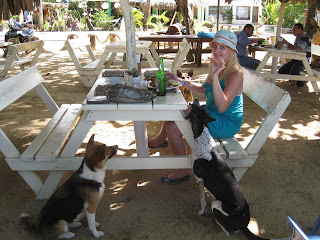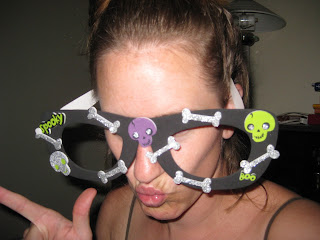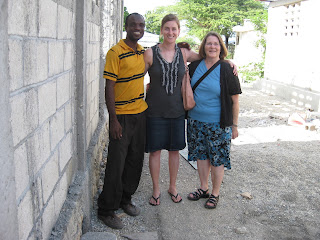Well, only three days left in beautiful sunny Haiti before I return to snow, temperatures below zero, and a life that is polar opposite to my current one. My last few weeks I’ve managed to visit almost every corner of Haiti. After my previous blog post I bumped and bounced some 8 hours with three Swiss folks and our Haitian driver to Cap Haitien. This is Haiti’s second largest city and the best part; still assembled! An earthquake leveled the city in 1842 but the city has been earthquake free since then. What a breath of fresh air (well diesel-infused fresh air) it was to be in a city that wasn’t collapsed. Sadly it is still doomed to fail if another earthquake hits and the other Swiss engineer, Jan, and I played name-that-building-that-will-fall-in-the-next-earthquake game in the car for entertainment. A little morbid but still fun.
Our first day we had plans to visit a huge mountain top fortress in the nearby looming mountains. This famous monument , the Citadelle, was constructed by Henri Christophe, a key leader during the Haitian slave rebellion, after Haiti gained independence from France at the beginning of the 19th century. Jan, our trip organizer, kindly arranged for us to visit the Citadelle on possibly the only gloomy rainy day in Haiti. Regardless we had a blast (in a drowned rat sort of way) and learned a lot. Well the French speaking folk (Swiss and Haitian driver) did. Our translator for the Citadelle and surrounding sites had difficulty remembering which one of us didn’t speak French (you’re truly) and proceeded to deliver most of the history to me in French. No worries, I wouldn’t remember it no matter the language spoken to me. I was more interested in the massive stone structure (130 feet tall) that has withstood several earthquakes and contains walls as thick as I am tall. The cannonballs scattered around the fortress were also fun to pick up as well as climbing around the entire structure. Luckily there are no rules for safety (besides our guide yelling “Attention” at us every 10 minutes) so there was no limit to where we could or couldn’t walk. Here’s the website for you history buffs. Pretty fascinating! http://en.wikipedia.org/wiki/Citadelle_Laferri%C3%A8re
The next day we followed a dirt road along the north coast to Labadie where we took a very small boat to our hotel which was only accessible by boat. A quaint little place with plenty of hammocks, beer, a mountain behind to climb the next morning at 6am, and dead seafood to eat for dinner. This would be where I tried my first lobster. If the cracking sounds to get to the meat off the lobster aren’t discouraging enough the crunchy meat inside will. Not delectable in my book.
So after my wild weekend across country, I flew into the next week giving my last workshop. Our limit for these workshops is 16 students. We were warned we may have as many as 30 students a few weeks prior which gave us opportunity to hire one more expat to help me give the workshop. Come Monday, I had 60 beady eyes ranging in age from 20-70 staring back at me anxious to learn. In Haiti I’ve developed this “don’t think, just do” mentality which has aided my apprehension for many things; mainly standing in front of large groups, entering houses that are far from stable, etc. This was in full effect come Monday. As most of these workshops have many malfunctions throughout the week, we found our site not prepped for concepts that we needed to teach. I like to call it improv teaching. Each hour goes differently then planned and I find myself pulling ideas out of my hiney right and left to make up for items we can’t teach simply due to the chaos. James would come back each day from teaching these workshops saying “Just another day in paradise” and I found myself succumbing to the brainwashing as well to eliminate pulling my hair out, throwing things, etc.
Finally by day two we had figured out how to control some 60 grown Haitian men, all of which have a different opinion on EVERY minuscule detail of masonry construction (including even how one ties the wire the holds rebar together). Johnny (our new engineer and my replacement), Sayem (the other expat that was hired to help), Raoul (my voice…a.k.a translator) and I arranged the men into sub-groups and monitored separate sessions of all parts of building that are important and that need to be changed in rebuilding Haiti.
All in all, this workshop and my final week has been the most rewarding week of my time spent here. I am flabbergasted at these Haitians’’ desire to learn. They ask question after question after question. I think we could have saved an entire day just for questions and they still wouldn’t be question free. Coming from a country where education is entirely taken for granted, I found myself immersed in a community that would kill for an education but simply can’t afford one. Some men have never taken a written test before in their life. Some can’t even write their name and had to provide their drivers license instead. For these men, we retested them orally. Several completely failed the written test but when asked the same questions orally aced it. One old man who didn’t pass either test told me his father couldn’t afford school for him so never sent him. He didn’t want to make the same mistake with his four children so he worked day in and day out to send all four to school. Now one is an architect and the other three completed (I didn’t understand what in) their school as well. He then proceeded to tell me how gracious he was that I had volunteered my time and patience for him. Heart wrenching. I wanted to pass him simply due to his situation. And there are hundreds upon thousands more in the same situation. It’s a funny world we live in. While some countries fight over which brand of epoxy to use on site, others merely scrounge for enough hand tools to even complete a job. Incredible.
My last weekend was spent driving with two co-workers down to the southwestern point of Haiti to a delicious sleepy little town called Port Salut. We stopped to check the structural integrity of a school on the way so we could call it work. It is here in Port Salut that the beaches are the bluest and the streets are the cleanest. As any trip of course isn’t complete without a river crossing we had the joy of such an activity a few hours before our destination. The “highway” was flooded with approximately 2 feet of water and our new Toyota Rav4 had its first swimming lesson. We arrived at our little cottage and much to our delight found one could practically fall out the front door into the ocean. We marveled at some antique wood row boats on shore which we later learned were not antiques but the “modern” boats they actually USED to catch the fresh fish each day.
 |
| Port Salut |
 |
| Port Salut |
 |
| Lobster cage |
 |
| Our little boat to Labadie |
 |
| Citadelle |
 |
| The walls of the Citadelle |
Well it’s the final countdown to homeward bound and I have to admit I’m ecstatic to return to life in the States. At the moment I’m more excited to go home then sad to leave but I know that will change as I adjust to life in the US and think back to my adventures here and the amazing people I have met and worked with. I feel like 4 months ago I stepped into a time machine that set me back some 70 years to a world where electricity was a luxury and TV dinners didn’t exist yet. Along with that comes fresh home cooked meals without preservatives, a chance to enjoy other’s company without the distractions of iphones and a hectic lifestyle, appreciation for a good book, and the opportunity to learn how peanut butter and sugar are actually made. I’ve found we are so far away from where we get our resources and where the waste goes in the US that we loose focus on appreciating how technology allows us to buy pre-chopped veggies on the cheap and walk down litter free roads. Parents only need to register their child for a free education versus pulling a 80 hour work week just to afford for their child to attend school (forget trying to feed the family). As hypocritical as it is to say, I think I will struggle with reaccepting the American fussy, or dare be it, snobby lifestyle. The pharmacy doesn’t have your medicine in stock (hey at least it carries it at all, and they have change for your 20 dollar bill so you can purchase it the next day) or waiting in the line at the bank for 30 minutes because service is poor (a good day in Haiti will put you around 2 hours) will be some things I may have to resist slapping people over. Having services like public toilets (and ones that <gasp> flush!) and restaurants or gas stations to buy food in within spitting distance of each other is something we need to cherish a hole heck lot more. Personally, not squishing biting ants in ones bed each night will be a plus as well as not living in the equivalent of a sorority and fraternity combined (guest house, it was my choice mind you). Hot showers will also be appreciated. I would sum up my experiences in Haiti as a life where constant struggle of the simplest things absorbs a significant portion of ones life and there is little energy left for advancement. Then you throw shattered politics into the kettle and finding despair comes easier than solutions. But this isn’t the mindset of the Haitian. They pray. They have hope. They smile and laugh. I think because life is tougher they are tougher. Put an American in a Haitian’s shoes and they’d die after a day. It’s mindboggling to me and I am so thankful I was able to be exposed to a glimpse of it.
So on that note I say “pase bon vwayaj Ayiti”. I look forward to seeing you and your progress again some day.















